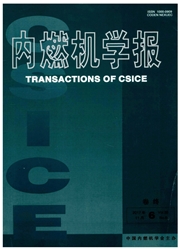

 中文摘要:
中文摘要:
在一台增压中冷电控高压共轨重型柴油机上利用科式流量计实测再循环废气流量实现了具有稳定性较好、测量精度及响应精度较高的EGR率适时测量,并在稳态测试循环条件下,转速为1650r/min时进行了恒转速增转矩瞬变过程发动机性能影响试验.结果表明:无论采用何种稳态工况EGR优化策略,将EGR率及喷油参数的优化结果运用于5s瞬变过程均会出现EGR率超调现象,碳烟排放严重恶化且消光烟度峰值超过50%;针对优化后的不同稳态负荷工况燃烧模式在瞬变过程中进行模式切换可以有效降低NOx排放,而通过EGR阀适时关闭策略则可明显改善碳烟的生成;优化瞬变过程各阶段油气混合比例及时问分布可有效抑制EGR率的超调,碳烟峰值降幅为20%.
 英文摘要:
英文摘要:
Real-time measurement of exhaust gas recirculation (EGR) flow with good stability, high accuracy and precision of EGR rate was made using the Coriolis flow meter on a turbocharged and intercooled heavy-duty high pressure common rail diesel engine. Engine performance at constant speed and increasing toque (CSIT)process were conducted under 1 650 r/min speed of steady test cycle condition. Test results show that applying the optimized EGR rate and injection parameters under ESC conditions to the transient process will cause a serious deterioration of soot emission regardless of any EGR optimization strategies, and smoke opacity increases up to 50% because of overshoot of EGR rate. Mode switching between opti- mized EGR and multi-injection coupled with EGR in transient process can effectively decrease NOx emissions while the strategy of timely EGR closure can obviously decrease the soot. Adjusting the air-fuel mixture ratio and time distribution in various stages of transient process can effectively control the overshoot of EGR rate and decrease the smoke opacity by 20%.
 同期刊论文项目
同期刊论文项目
 同项目期刊论文
同项目期刊论文
 期刊信息
期刊信息
